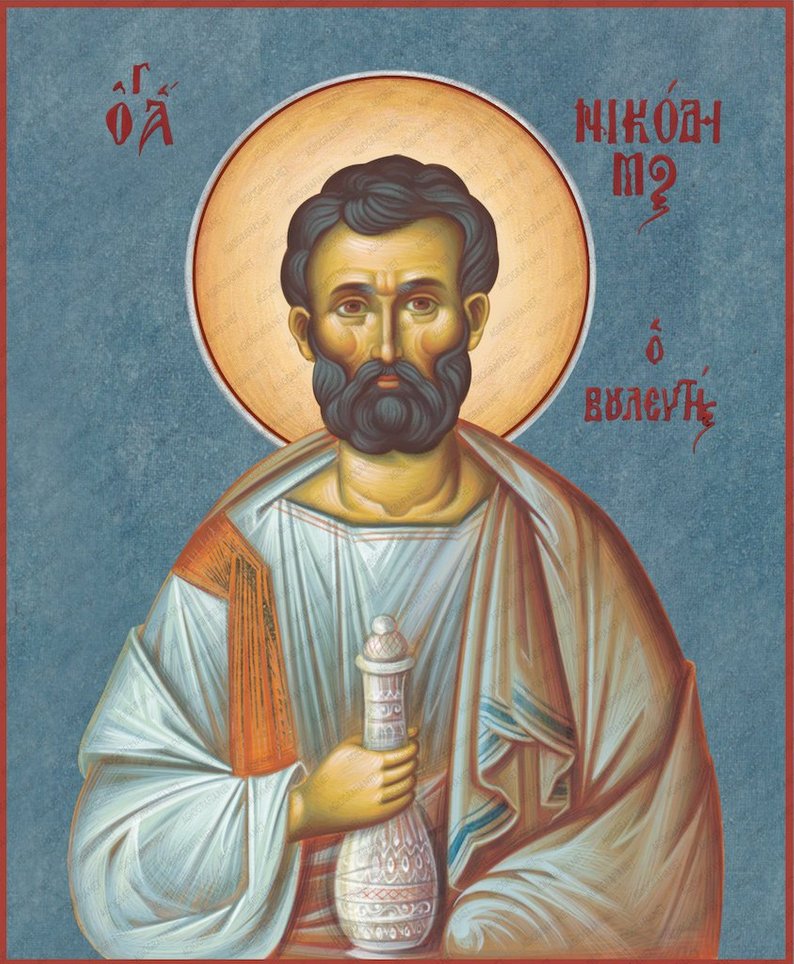Christ is risen! Truly He is risen!
by Archangel Voices (on Orthodox Christian Chants site) from their album “Resurrection! Orthodox Chants and Hymns of Holy Pascha”
Today’s Post is a “new and improved [slightly] [perhaps] version” of a 2020 Post. (I’m taking a week off from original thinking.)
Our Paschal lectionary is leading us, day by day, through the Gospel according to Saint John. I hope you’re following along: https://www.goarch.org/chapel/ or http://www.antiochian.org/liturgicday
During Paschal season, the Fathers selected certain significant stories from John for us to hear on Sundays. However, for reasons not explained, this Sunday’s is from Saint Mark.
Gospel: Mark 15:43-16:8
Is it legal to begin with the morals of the story? Who cares? They are: 1 Don’t cooperate with the rats. 2 Do your duty. 3 Never fail to help the needy.
Let’s take today’s saints in order of their appearance in the narrative.
Saint Joseph of Arimathaea
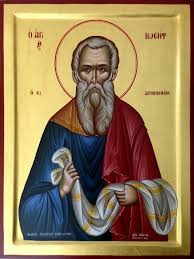
Most icons with permission of Saint Isaac’s Skete, skete.com
Arimathaea was a town (now long gone) just outside Jerusalem. Matthew 27:58 says Joseph bravely went to Pilate and asked for the body of Jesus and laid it in his own new tomb, likely intended for members of his family – as Jesus possibly was. (More on that in a minute.) It was a cave, since 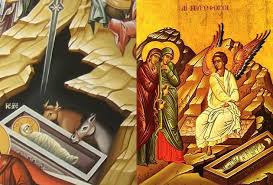 there isn’t much soil for burial around in the region. Note the double symbolism: Both at Christ’s Birth and at His Resurrection, new Light for the world came forth from the darkness of a cave.
there isn’t much soil for burial around in the region. Note the double symbolism: Both at Christ’s Birth and at His Resurrection, new Light for the world came forth from the darkness of a cave.
Joseph was a member of the Sanhedrin, the Jewish high council which had condemned Christ to death on Holy Friday morning – “a good and righteous man, who had not consented to their decision or action… and was waiting for the kingdom of God.” Luke 23:50-51 – “a rich man …who had himself become a disciple of Jesus.” Matthew 27:57. That’s all we know about his background.
Tradition in both East and West says that after the Resurrection Joseph was expelled from the Sanhedrin, fled Jerusalem and went to England. A British tradition goes on to say that Joseph was uncle of the Virgin Mary, that he had made his money trading tin between the mines of Cornwall and the Middle East. The Cornish say that on one voyage he took the boy Jesus with him!
This was the inspiration for the hymn (first verses below) which is sung at almost all British national events – here the wedding of Prince William and Kate Middleton in 2011. (I will say the Brits still know how to do it up right.) It was written by William Blake (d. 1827), a vaguely-Christian mystic. Considering that 1) the latter verses make little obvious sense, and 2) Britain is now largely post-Christian, I wonder how many people have any idea what they’re singing about. The melody is lovely. Note the small icons on the right and left pillars.
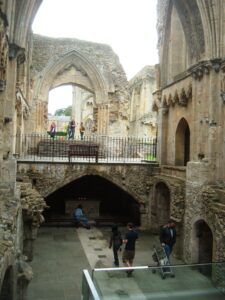 The British tradition goes on to say that Joseph had trouble with a druid chieftain and so fled southwest to a place called Glastonbury, which became the first Christian settlement in Britai
The British tradition goes on to say that Joseph had trouble with a druid chieftain and so fled southwest to a place called Glastonbury, which became the first Christian settlement in Britai
Here are the ruins of Glastonbury Abbey. Who ruined it? Henry VIII and others of his sort.
An ancient thorn bush grew there, said to be descended from the crown of thorns which Joseph removed from the Lord’s head. Khouria Dianna and I saw the Glastonbury bush before it died in 1991. (We didn’t do it!) I’ve wondered if it gave up in disgust, because by then Glastonbury had become a New Age center. The French, however, say the real crown of thorns is in Notre Dame Cathedral and escaped the recent fire.
A later very dubious legend says Joseph brought the Holy Grail (the cup from the Last Supper) to England, the quest for which was the principle occupation of King Arthur and his knights. Some still search for it, believe it or not.
Joseph of Arimathaea died in England, far from homeland and family and all he had known. He did it all for the risen Christ. His relics were venerated at Glastonbury till they were destroyed by Henry VIII (him again).
Saint Nicodemos
John says Nicodemos (“…os” is from the Greek spelling: “Νικόδημος”) was a Pharisee and a “ruler of the Jews”, also a member of the Sanhedrin. Early in Jesus’ ministry he went to Him by night (afraid of being seen) seeking truth. To Nicodemos Christ said “You must be born again of water and the Spirit” * John 3 When the Pharisees condemned Jesus, Nicodemos objected: “Does our law condemn a man without first hearing him to find out what he has been doing?”John 7:51 It is said he was martyred by the Jews. John writes as if Nicodemos was someone known to his readers.
- In the New Testament, being born again – “new birth”, “rebirth”, “regeneration” – refers to Baptism and the gift of the Holy Spirit in Chrismation. We can also have moments of powerful spiritual renewal which bring us closer to God or guide us, which some call being “born again”. They can be a very good thing, if kept within the Tradition of the Church. (I’ve had such experiences at least three times now and, God willing, I hope my death will bring a fourth.) However we are born into eternal life in Christ once – in Holy Baptism. All else flows out of that.
The Holy Myrrhbearing Women
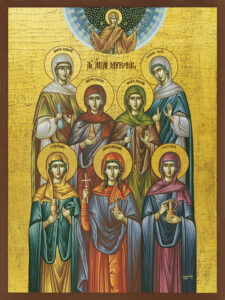
Mark names three: Mary Magdalene, Mary the mother of Joses, and Salome. Luke adds Joanna. Both accounts say there were others. Tradition adds Mary, Martha and Susanna to make seven. Some add an eighth, Mary the wife of Cleopas.
1 Mary Magdalene (from Magdala near the sea of Galilee) followed Jesus from early in His ministry. Christ healed her of “seven demons”, which was a way of saying she’d had big problems. Western Christians claim she had been a prostitute, but nothing in the Bible or ancient Tradition says this.
Mary Magdalene was first to meet the risen Lord. After the others had hurried into the city to tell the Apostles the tomb was empty and angels had told them Christ had risen, Mary remained in Gethsemane and through her tears saw someone she took to be the gardener. He turned and said to her “Mary”. Mary ran and old the Apostles, “I have seen the Lord!”
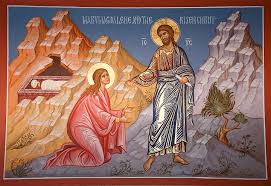
We read this story every eleven weeks at Sunday Matins, and every time I get the holy chills. It is so filled with… … I can’t express it in words. Please read it: John 20:11-18 or, better, come to Matins and hear it read aloud.
Orthodox title Mary “Isapostolos” ἰσαπόστολος, “Equal to the Apostles”. Legend says she later went to Rome and gave Tiberius Caesar a red egg, saying “Χριστός Ανέστη!” – just as we still distribute red eggs at Pascha. It is more certain that she lived in Ephesus near John the Theologian and the Lord’s Mother. Some French say she later went to Provence, but I don’t think so. She has her own feast day, July 22.
2 Salome, wife of Zebedee the fisherman, mother of the Apostles James and John. Tradition says she was cousin of the Virgin Mary, which would explain why young John was His “beloved disciple”.
3 Joanna wife of Chuza, Herod’s steward. She rescued the head of John the Baptist and later assisted the Apostles in Jerusalem.
4 Susanna, known only as a friend of Mary Magdalene.
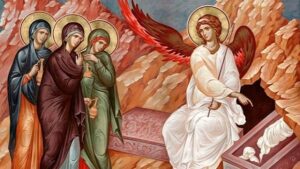 5 and 6 Mary and Martha whom you know well – sisters of Lazarus, friends of the Lord Jesus, at whose home in Bethany He stayed when He was in Jerusalem – notably during Holy Week.
5 and 6 Mary and Martha whom you know well – sisters of Lazarus, friends of the Lord Jesus, at whose home in Bethany He stayed when He was in Jerusalem – notably during Holy Week.
7 Mary mother of James and Joseph Matthew 27:56 or of James the younger and of Joses. Mark 15:40
And possibly 8 Mary the wife of Cleopas, the man who with Luke walked unknowingly with the risen Lord on the road to Emmaus.
I hope I’ve kept these straight.
Why did these Blessed Ones perform these acts of charity?
For us who know Christ is risen, it is hard to grasp how utterly despairing and despondent these people were as they cared for the Body of Jesus. Remember the sweet but mournful hymn from Holy Friday: “Noble Joseph, took down Thy most pure Body from the Tree, anointed it with spices, wrapped it in clean linen, and laid it in a new tomb.” And that, they thought, was the end of the song.
However, on the Third Sunday of Pascha we sing it again, now adding a verse: “But on the third day You arose, O Lord, granting great mercy to the world.”
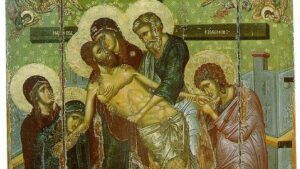 Saint Marina Church, Kalopanagiotis, Cyprus, 14th c
Saint Marina Church, Kalopanagiotis, Cyprus, 14th c
When Joseph asked for the Lord’s Body there was nothing he could possibly gain out of this, and everything to lose. He had lost hope, now, that this Man had been the Messiah.There could be no reward from a corpse. His fellow members of the Sanhedrin were already greatly suspicious of him for his disloyalty – why had he not adhered to the party line? why had he not voted to condemn Jesus? this Man whom they had condemned to death for blasphemy and the Romans had executed for treason.
So why did he do it? The Gospel account doesn’t tell us – but my guess is that it was more than simply an act of charity. I suspect Joseph was also trying to redeem his virtue. Though he had quietly refused to condemn Jesus, surely he was now saying to himself: If only I had spoken up, tried harder to stop this… He knew first hand how unjustly the Sanhedrin had condemned this innocent Man, and how utterly blasphemous they were – they were the blasphemers! not Him – when they sold out to Rome, crying to Pilate “We have no king but Caesar”. Jesus had been right: they were hypocrites, whitewashed tombs. Likewise, Pilate knew Christ was innocent. “Why, what wrong has he done?” “I find no fault in him” – but then he had literally washed his hands of the matter, sacrificed his conscience and condemned this innocent Man to death, in order to calm things down and save his career. It was all enough to make Joseph want to wash his own hands with lye soap.
So my guess is that Joseph’s conscience said to him: That’s it. That’s as far as I go! I may lose it all, but I’ve got to do something to prove that I’m not one of “them”, and that I do not stand with that self-seeking politician who cares only for himself.
And so in order to try to become an honest man, to redeem his character, Joseph acted now in a way everyone would see. He “went and asked for the Body of Jesus” – never imagining what would come of it: Christ risen from the dead! And that twenty centuries later it would be from Joseph’s own tomb that the Holy Fire still miraculously appears every Pascha.
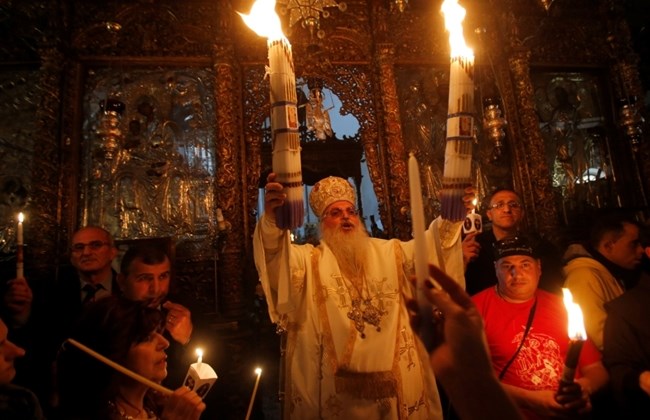
And that every Pascha in 100,000 Orthodox churches and monasteries all around the world, priests would come out from the Altar as if from Joseph’s tomb chanting, “Come, take light from the Light that is never overtaken by night”.
All from this one act of repentance and charity.
Why did the Holy Myrrbearers anoint the Body of Jesus? This is simpler: Duty. They likewise had no expectation of what was about to happen. But anointing the bodies of the dead in those days was women’s work, and they hadn’t completed it on the eve of the Sabbath when such things couldn’t be done. So as soon as they could they went to do it. Duty. And so they were first to know Christ risen from the dead.
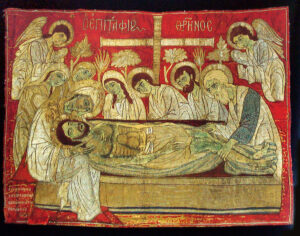
Epitaphios
1599, Benaki Museum, Athens
Nor could any of them have imagined the other lasting and visible results of what they did: Their image, along with that of the Body of Christ, is on the Epitaphios, the cloth which is venerated in church on Holy Thursday, carried in the Holy Friday “burial procession”, and then lies on the Altar for the Forty Days of Pascha. “Christ is risen from the dead, trampling down death by death”.
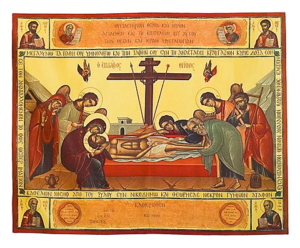
Antimension
at Saint Peter’s Orthodox Church, Fort Myers, Florida
That same image is on another cloth: the Antimension, on which the Bread and Wine are blessed. Out of the life-creating Death of Christ comes the Holy Eucharist, the Bread of Heaven, the Cup of Salvation.
They were a part of it all. 2000 years later they still are a part of it all! – Joseph and Mary Magdalene and Salome and Joanna and Mary and Martha and the other Marys.
So, to repeat:
The Morals of the Story
1 Like Joseph, do what is right, not counting the cost. Don’t cooperate with the rats. (Can you think of any applications of this moral in today’s world?) And if you have failed, repent quickly and do anything you can, take whatever penalty is involved, in order to make up for it, as best you can.
2 Like the Myrrhbearers, do your duty. Do what you ought to do, even when it’s hard – hard to be faithful to your Lord, to your Church, to your spouse, to your family, to your Faith.
3 Like all of them, never fail to practice charity, especially towards the poor and abandoned. Jesus was once one of these, wasn’t He? In fact He told us He still is. When we minister to them we minister directly to Him.
That’s it. Simple. But not easy.
When we do these things, perhaps it will gain us nothing but trouble.
On the other hand something wonderful, life-giving, world-shaking might come of it – even if not till long after we’re gone. It could be.
However we do know something quieter that will definitely come of it now: We will know the risen, living Christ for ourselves. That is His promise: “He who has my commandments and keeps them, it is he who loves me. And he who loves me will be loved by my Father, and I will love him and manifest myself to him… and we will come to him and make our home with him.” John 23:21,23
You will know, within yourself, the presence of the risen and living Christ.
![]()
Next Week: The Paralytic – Christ says: Arise! Arise! Arise!
Week after Next: The Samaritan Woman – How Jesus “leads us onward and upward”
